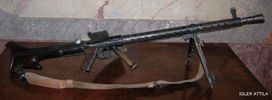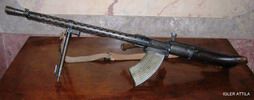![]() The 31 M. Solothurn bullet throwers
The 31 M. Solothurn bullet throwers
are the 8 mm 31 M. and the 7.92 mm 43 M. bullet thrower

History
Modern machine guns that appeared at the end of the nineteenth century fundamentally changed warfare. These At the same time, the weapons were rather cumbersome, and moving them on the battlefield was hardly easier, like that of an infantry cannon. Fast-moving troops needed a lighter weapon that it was finally born in Denmark, and its first representative became the Madsen bullet thrower. Although the Madsen was already involved in the Russian-Japanese War, the bullet thrower However, its use was not widespread at the time.
Soon after the outbreak of World War I, which began as a traditional conflict, it became a new type of standing war formed (mainly in the west, less so in the east), which seemed to favor the heavy, stationary firing position firing machine guns. However, it soon became apparent that offensive operations were carried out by weapons can cover it at most from a distance. For direct support of advancing infantry, other tools had to be found.
Each country has approached this problem in different ways. France, England and The United States, which later entered the conflict, gave its troops a light automatic weapon. The American Browning Automatic Rifle (BAR), although originally designed as a semi-automatic rifle, has a large weight Because of this, he eventually became more of a bullet thrower, with a two-legged stand on the barrel of his later versions mounted. However, the Englishman Lewis and the French Chauchat (which came second It was also introduced in Hungary during World War II) were real bullet throwers.
However, Germany and especially the Monarchy did not have a strained arms production capacity The opportunity to start producing an entirely new weapon, so they chose a different path. Germany equipped its Maxim-system MG 08 machine gun with a new lightweight bipedal stand and and registered as MG 08/15 as a light machine gun. By 1918, the heavy water-cooled The barrel was also replaced with air-cooled, and the weapon was equipped with a switchable strap mount. True However, bullet throwers could not be used by the German army until the end of the war. (This is the disadvantage It also led to the birth of a lighter serial shooting weapon, the submachine gun.)
The Austro-Hungarian Empire was forced to choose this path: with a small tripod and Instead of 250, the 7/12 M. Schwarzlose machine guns were equipped with lighter straps containing 100 rounds. However, they were only in name Light machine guns, the basic weapon remained virtually unchanged. Nevertheless, the Monarchy should, as the army of the later independent Kingdom of Hungary, this emergency solution was necessary Apply.
The situation began to change only in the mid-20s, when the Hungarian Defence Forces entered the system claimed the Madsen bullet thrower, which was already quite alive at the time. However, since this weapon did not work with the standard rifle cartridge, it was new, this time logistical It posed a problem for the already struggling military leadership.
A solution was needed that met all needs.
Origin, the Solothurn 2-200 bullet thrower
The peace dictates that ended the World War had an unexpected effect on the arms race. While the confident winners sat back comfortably and did not They developed and even downsized their military industry, while the losers were pressed on all sides He was driven to a desperate search for a way by outrageously unfair restrictions.
Like Hungary, Germany has also been subjected to military restrictions that have already affected the country’s They rendered the army incapable of merely defending it. No wonder the leadership of both countries (in fact, the whole country) circumvented these provisions wherever they could. It is characteristic that above this Often even the less strict Italian or Anglo-Saxon inspectors of the Entente turned a blind eye. Not so the They are raucous Frenchmen who, however, willingly or unwittingly only build on the strengths of the future Axis powers primed…
Therefore, part of the German military industry, if it wanted to function, had to emigrate from the country. In this It was during this period that the threads of German-Soviet military cooperation were closely linked, and the German military industry into the industry of Switzerland, the hitherto neutral tiny Central European mountain paradise.
One of the targets was the small Waffenwerke Solothurn, a company that bought part of its shares in the German Rheinmetall-Borsig. Under the influence of investments and engineers from Germany, a A real arms factory was born, which is now restricted outside the German borders, on neutral territory could work without it.
It was at this plant that the Solothurn 2-200 was born, designed by the German Louis Stange, the creator of the later MG 34 machine gun bullet thrower, which was eventually brokered by Austria and the new pointed Mannlicher developed in Austria He also reached Hungary with ammunition. Since the Austrian M. 30 rifle cartridge was converted to Mannlicher repeater rifles, the military had already adopted it wished, it seemed reasonable to obtain a bullet thrower powered by this ammunition. Not only the weapons, but also the manufacturing rights, were purchased, and soon the 31 M. preparations for the manufacture of a weapon known as the bullet thrower.
This was not the only relationship between Danuvia and its Swiss partner. Also a Solothurn license The 36 M. heavy rifle was also produced by the factory. The designer of his submachine guns, Pál Király, is another Swiss arms manufacturer, the still famous He was a respected employee of SIG in the 20s.
Production in Hungary
Danuvia had already produced thousands of bullet sprayers before 1938, with a production capacity of 240 per month volt. However, it was only possible to ramp up production with the start of the military development programme Calculate. After an encouraging start, however, it soon became clear that the 600 bullet sprayers per month were supplied by HM You can no longer constantly take over. The factory’s negotiations in Germany were also unsuccessful, initial interest in the Solothurn bullet thrower soon ceased. Oddly enough, HM is newer His orders did not improve the situation either. Irregular orders and subcontractors delays created difficulties in production that caused Danuvia to He was constantly behind on delivery.
In 1942, a unified unit capable of performing both bullet thrower and machine gun functions arose The idea of standardizing machine guns, and by mid-1944 Hungarian and German troops were already The unification of its armaments was discussed, but these remained only plans. The 31 M. bullet thrower accompanied the Hungarian Defence Forces until the end of the war, the number of weapons completed It could well exceed ten thousand.
The 31 M. bullet thrower
Ammunition: 31 M. live cartridge
Ammunition: 31 M. grain cartridge (steel-core bullet against armoured targets)
Ammunition: 31 M. light-signaling cartridge (steel-core cartridge with light indicator)
Ammunition: 31 M. firing cartridge ( ammunition indicating impact with smoke cloud)
Ammunition: 36 M. target bullet (on impact ammunition with a crushing projectile)
Ammunition: 31 M. test cartridge (increased powder-loaded cartridges for testing manufactured weapons)
Ammunition: 38 M. signal body (rifle cartridge shape adapter for 6 mm 36 M. bang cartridge)
Ammunition: 6 mm 36 M. bang cartridge ( blank cartridge for training)
Storage capacity: 25 rounds in
a curved cabinet magazine Rate of fire: 600 rounds per
minute (theoretically; in practice, due to magazine changes, this is about 50-75 rounds per minute)
Projectile starting velocity: 730 m/s
Muzzle energy: 363.9 mkg
Range: theoretical 4400 m, practical 2000 m
Sight: curved, graduation from 100 to 2000 m, marked
every 100 meters Weapon length: 1170 mm
Weight: 9.5 kg
Barrel length: 600 mm
Barrel weight: 1.8 kg
Drag: 4, rightDescription:
Externally an air-cooled weapon resembling the German MG 34 from the left side with insertable arched cabinet magazine, double-legged fork stand attached to perforated tube jacket, wooden with shoulder rest, pistol grip and characteristically sideways and forward front grip, which acts as a carrying handle in the upper position. Strongly raised due to straight shoulder rest sight line is slightly shifted to the left. For a few bullet throwers per unit for one anti-aircraft purpose It can also be applied heavy stand.
The short recoil gun locks a concentric rotary latch type.
The bullet launcher was equipped with three tubes for continuous firing, into which were marked “A”, “B” and “C”. A fourth training tube is also included, which is 2.5 cm longer and galvanized with copper. Since this tube is used for the weaker 6 mm 36 M. bang cartridge, In the place of the flame concealer there is a sleeve that strengthens the recoil. When using a bang bullet, after 150 shots, the firing must be stopped until cooled down, because due to the heated tube, the rate of fire of the bullet thrower rises.
Its transport is facilitated by a leather carrying strap that allows the bullet sprayer to be shouldered.Its main parts are:
the tube, lock sleeve and locking device;
sight;
the lock;
the case and tube jacket;
the firing device, as well as
the shower and shower holder.


